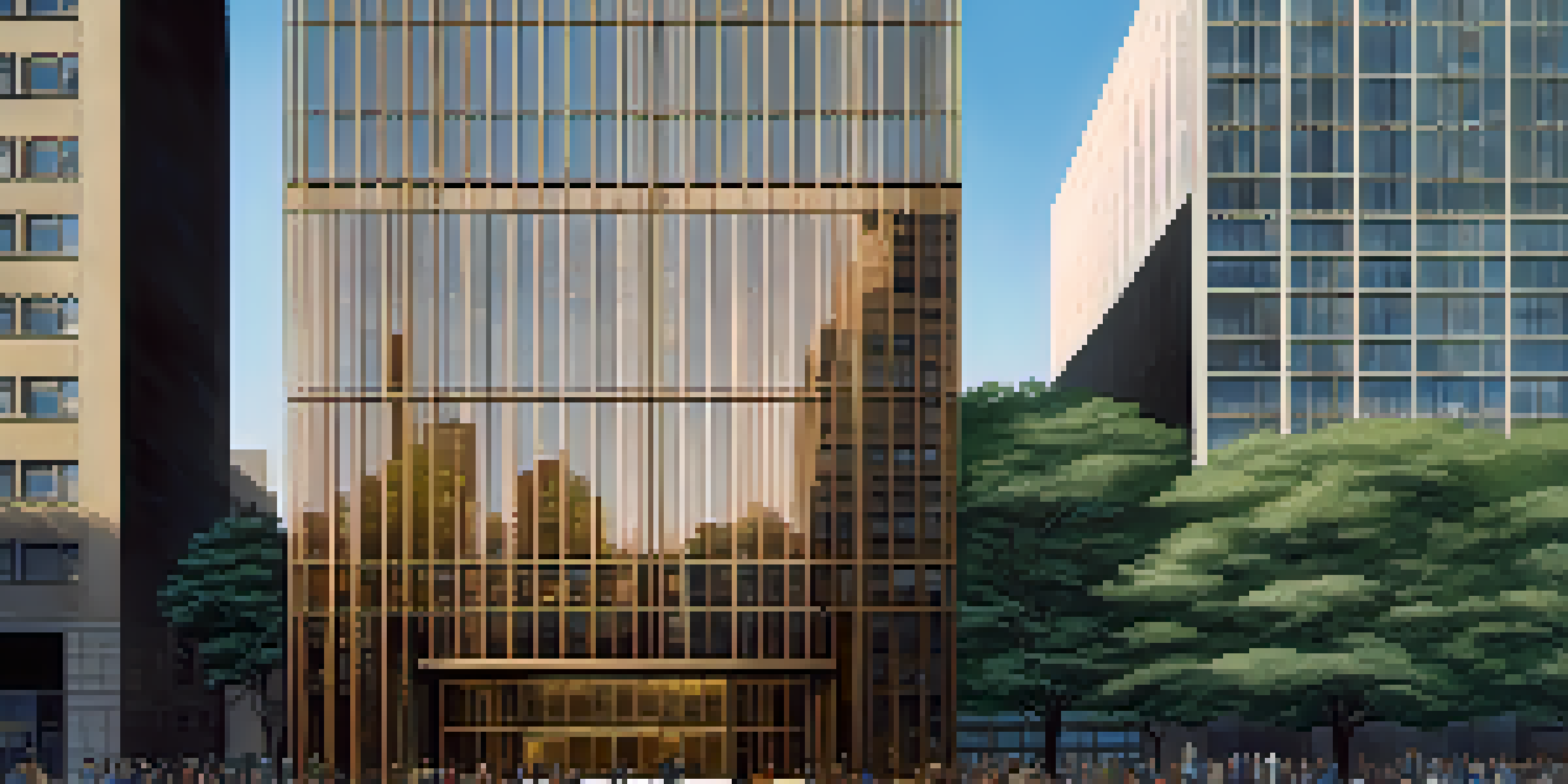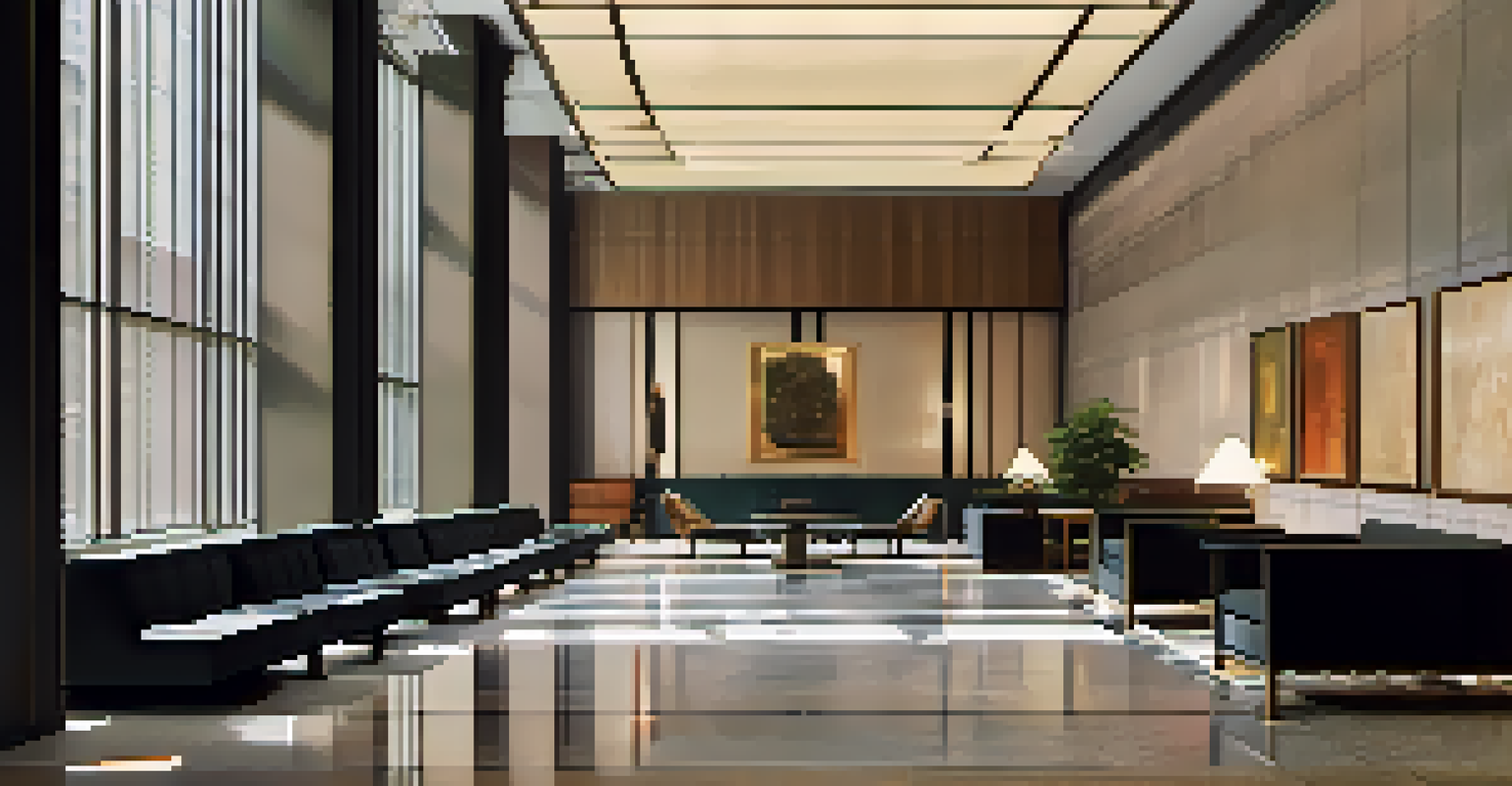Modernism in NYC: The Unique Design of the Seagram Building

The Birth of Modernism in New York City
Modernism emerged in the early 20th century as a response to traditional architectural styles. In New York City, this movement sought to reflect the dynamic changes in society, industry, and technology. The Seagram Building, completed in 1958, stands as a prime example of this architectural shift, showcasing a new way of thinking about space and form.
Less is more.
As cities grew and evolved, architects started to prioritize function and simplicity over ornate designs. This change was influenced by European modernist movements, which emphasized clean lines and minimal decoration. The Seagram Building embodies this philosophy, with its sleek glass and bronze façade that captures the essence of modernism.
The building's design not only transformed the skyline but also redefined how urban spaces could be utilized. It sparked a conversation about the role of architecture in everyday life, making it a landmark of modernist thought in one of the world's most vibrant cities.
Design Elements That Define the Seagram Building
Designed by the renowned architect Mies van der Rohe, the Seagram Building is known for its striking use of materials and proportions. The bronze-tinted glass panels reflect the surrounding urban environment, creating a dialogue between the building and its context. This choice of materials is not just aesthetic; it also speaks to the era's industrial advancements.

The building’s minimalist design is characterized by its clean lines and geometric shapes, which embody the modernist principle of 'less is more.' The open plaza in front of the Seagram Building invites public interaction, contrasting the more closed-off designs of previous architectural styles. This integration of public space with private buildings was revolutionary at the time.
Modernism's Impact on NYC Architecture
The Seagram Building exemplifies how modernism shifted architectural design in New York City, emphasizing functionality and minimalist aesthetics.
Additionally, the Seagram Building's height and form emphasize verticality, a hallmark of modern skyscrapers. The building rises majestically, yet its design allows it to coexist harmoniously with the surrounding structures, proving that modernism can be both bold and respectful of its environment.
Influence of the International Style
The Seagram Building is often associated with the International Style, a movement that sought to establish a universal architectural language. This style is marked by an absence of ornamentation and a focus on volume over mass, which can be seen in the building's streamlined design. The use of industrial materials further ties it to this global architectural trend.
Architecture is the will of an epoch translated into space.
Mies van der Rohe's application of the International Style set a precedent for future skyscrapers in New York City and beyond. The Seagram Building's emphasis on functionality and aesthetic simplicity influenced countless architects who followed. It demonstrated that modern buildings could be both visually striking and practical, paving the way for the skyscrapers that dominate urban landscapes today.
By embodying the principles of the International Style, the Seagram Building helped to redefine what a corporate structure could be. It became a symbol of modern architecture, showcasing how design could reflect the values and aspirations of a new age.
The Role of Public Space in Modern Architecture
One of the most significant contributions of the Seagram Building is its approach to public space. The building features a generously sized plaza that encourages people to gather and interact, breaking down the barriers often seen in urban settings. This integration of public areas into architectural design is a hallmark of modernism.
The plaza not only serves as an entrance but also as a social hub, inviting pedestrians to pause and enjoy the surroundings. This idea of creating spaces that foster community interaction was revolutionary at the time and has influenced many subsequent designs in urban architecture. The Seagram Building thus became a model for how modern structures could enhance public life.
Public Space as a Design Priority
The Seagram Building's integration of a public plaza revolutionized urban architecture by fostering community interaction within architectural spaces.
By prioritizing public space, the Seagram Building challenged the notion that buildings should be solely functional or aesthetic. Instead, it showcased how thoughtful design could create environments that promote social connection, a principle that remains relevant in architecture today.
Cultural Impact of the Seagram Building
The Seagram Building is not merely an architectural feat; it has also made a profound cultural impact. It represents a shift in how people perceive urban environments, emphasizing the relationship between architecture and culture. The building has become a symbol of corporate success and modernism, attracting visitors and architects alike.
As a part of New York’s architectural identity, the Seagram Building has been featured in countless films, art pieces, and literature, cementing its status in popular culture. It stands as a backdrop for stories of ambition, innovation, and the American Dream, reinforcing its significance beyond just bricks and mortar.
Moreover, the Seagram Building's design has inspired a host of similar projects around the world, influencing how modern corporations approach their headquarters. Its legacy continues to shape the conversation about modern architecture and its role in society, making it a pivotal landmark in New York City.
Sustainability and Modernist Architecture
In recent years, the conversation around architecture has increasingly focused on sustainability. While the Seagram Building was designed long before this became a pressing issue, its minimalist approach aligns with many principles of sustainable design. The use of high-quality materials and efficient construction methods reflects a commitment to durability and longevity.
Modernist architecture often emphasizes natural light and open spaces, both of which can reduce the need for artificial lighting and improve energy efficiency. The Seagram Building's large windows not only provide stunning views but also allow for ample natural light, creating a more pleasant working environment while minimizing energy consumption.
Sustainability in Modern Design
While designed before sustainability became a focus, the Seagram Building's minimalist principles align with modern sustainable architecture practices.
As architects revisit the principles of modernism, the Seagram Building serves as a reminder of the importance of thoughtful design. By blending aesthetics with function, it encourages a more sustainable approach to urban development, highlighting that good design can be both beautiful and environmentally responsible.
The Seagram Building: A Timeless Icon
Despite being over sixty years old, the Seagram Building continues to be a relevant touchstone in architectural discussions. Its design has stood the test of time, proving that modernist principles can create structures that are not only functional but also timeless. This enduring quality is a testament to Mies van der Rohe's vision and craftsmanship.
The building remains a popular destination for architecture enthusiasts and tourists, drawn by its iconic status and historical significance. It serves as a living classroom for those looking to understand the evolution of modern architecture and its impact on urban life. The Seagram Building's legacy is not just in its design but in its ability to inspire future generations.

In a rapidly changing world, the Seagram Building reminds us of the power of architecture to shape our experiences. As cities continue to grow and evolve, this landmark stands as a beacon of modernism, encouraging a blend of innovation, sustainability, and community in urban design.